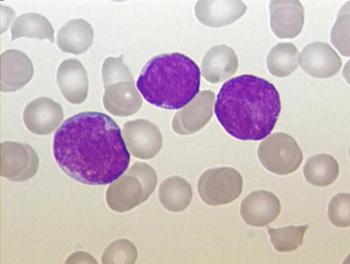
Xevinapant Plus CRT Improves Survival in Locally Advanced Squamous Cell Carcinoma of the Head and Neck
The first-in-class inhibitor of apoptosis protein (IAP) antagonist significantly improved overall survival in patients with LA-SCCHN.
Xevinapant (Debio 1143), in combination with standard cisplatin-based concomitant fractionation chemoradiation therapy (CRT) reduced the risk of mortality by half compared with CRT alone in patients with locally advanced squamous cell carcinoma of the head and neck (LA-SCCHN, according to updated phase 2 data presented as part of the 2020 ESMO Virtual Congress.1
“This is probably the first time in 30 years that such an overall survival benefit [has been] seen when compared to cisplatin radiotherapy in this type of cancer,” said Jean Bourhis, MD, professor in the Department of Oncology at the University of Lausanne in Switzerland. Bourhis added that these results have warranted a 5-year extended OS follow-up for the phase 2 study.
Investigators randomized 94 patients in the phase 2 portion of the study 1:1 to CRT in combination with xevinapant (n = 48) or placebo (n = 47). At median follow-up of 33 months results showed that xevinapant in combination with CRT reduced the risk of death by 51% versus placebo (HR, 0.49; 95% CI, 0.26-0.92). The updated overall survival (OS) rates were 66% (95% CI, 49%-78%) compared with 51% (95% CI, 34%-65%) in the xevinapant arm and placebo arm, respectively. Further, the median OS was not reached in the xevinapant arm versus 36.1 months in the placebo arm (95% CI, 21.8%-46.7%).1
Progression-free survival data for patients treated with xevinapant also showed statistically significant improvement over placebo, reducing the risk of disease progression or death by 66% (HR, 0.34; 95% CI, 0.17-0.68; P = .0023). The probability of PFS at 36 months was also improved to 72% compared to 36%, respectively.
The median locoregional control (LRC) was not met in either arm (HR, 0.47, 95% CI, 0.19-1.15; P = .095) and the LRC rates were 78% and 56% respectively. This improvement is in line with the 2-year analysis presented in 2019 in which the primary end point was met.
Xevinapant is a potential first-in-class oral antagonist of inhibitor of apoptosis proteins that sensitizes tumor cells to CRT by promoting programmed cell death and fostering antitumor immunity.2 Investigators hypothesized that xevinapant may optimize the efficacy of CRT as these proteins are overexpressed in squamous cell carcinoma of the head and neck.1 Improved survival and locoregional response rates suggests that xevinapant has the potential to fill an unmet need for this patient population that, despite being one of the most common malignancies worldwide, experiences relapsed disease in approximately 50% of cases.3
The FDA granted xevinapant a breakthrough therapy designation in February 2020, based on the 2-year follow-up results.2
Safety Remains Predictable/Manageable
Cisplatin CTR is associated with acute and late toxicities that are often irreversible including hearing loss and renal failure, resulting poor treatment adherence among patients.3 Overall treatment compliance for the study was comparable between the two arms. “Importantly, the addition of xevinapant resulted in a good safety profile, which did not compromise the standard of CRT delivery,” said Bourhis.
Updated safety analysis of the incidence of selected late toxicities, those occurring more than 30 days after the last administration of the investigational treatment, were also reported.
“Overall when we summarize the safety of this study, the treatment emergent adverse events [AEs] didn’t change from the 2-year analysis and regarding the late toxicity, we have a slight increase in grade 1 and 2 late toxicities reported in the xevinapant arm, but no difference in grade 3 or 4,” said Bourhis.
Rates for the incidence of any late toxicity were 50.1%, 16.7%, and 6.3%, for grades 1/2, 3, and 4, respectively, in the xevinapant arm compared with 40.4%, 17.0%, and 6.4% in the placebo arm. Specifically, the leading grade 1/2 AEs were dry mouth (25.1% vs 19.1%), dysgeusia (14.6% vs 8.5%), fibrosis (12.5% vs 8.5%), dysphagia (8.3% vs 6.4%), dysphonia (8.3% vs 14.9%), and deafness/hypoacusis (8.3% vs 8.5%).1
Grade 3 AEs in the xevinapant arm that were included in the analysis were comprised of 3 patients with dry mouth (6.3%), 2 with dysphagia (4.2%), and 1 each with dysgeusia (2.1%) or deafness (2.1%). One patient (2.1%) in the analysis was reported to have experienced grade 4 dysphagia. Comparatively, grade 3 AEs reported for the placebo arm included 3 patients with dysphagia (6.4%), 2 each with dry mouth (4.3%), dysgeusia (4.3%), deafness/hypoacusis (4.3%), and 1 with fibrosis (2.1%).1
“We can say that the safety with xevinapant was predictable and manageable without increases in severe toxicities,” Bourhis added.
Investigators will further examine event-free survival in patients with LA-SCCHN in the planned phase 3 randomized TrilynX trial (NCT04459715). An estimated 700 patients will be enrolled and randomized to CRT in combination with xevinapant or placebo for 3 cycles, followed by monotherapy with either xevinapant or placebo for 2 cycles.
References:
1. Bourhis J, Sun XS, Le Tourneau C, et al; GORTEC Investigators. 3-year follow-up results of the double-blind, randomized phase II trial comparing concurrent high-dose cisplatin chemoradiation plus xevinapant (Debio 1143) or placebo in high-risk patients with locally advanced squamous cell carcinoma of the head and neck. Presented at: 2020 European Society for Clinical Oncology Virtual Congress; September 19-21, 2020; virtual. LBA39.
FDA grants breakthrough therapy designation for Debiopharm’s novel chemo-radio sensitizer 2. Debio 1143 for front-line treatment of head & neck cancer. News release. Debiopharm International SA. February 27, 2020. Accessed September 19, 2020. https://bit.ly/2Vurl1x
3. Porceddu SV, Scotté F, Aapro M, et al. Treating patients with locally advanced squamous cell carcinoma of the head and neck unsuitable to receive cisplatin-based therapy. Front Oncol. 2019;9:1522. doi:10.3389/fonc.2019.01522
Newsletter
Stay up to date on recent advances in the multidisciplinary approach to cancer.

















































































